Toilet float: device, adjustment rules and replacement example
Over time, obsolete plumbing fixtures are replaced by new, more comfortable and functional ones, but some details remain the same, almost without changing their purpose.
For example, one of the most important elements of the drain tank - a toilet float - continues to perform its main function of adjusting the water level, although it also underwent external changes.
You must admit that understanding of the device of the float mechanism will be useful to any home master. Calling plumbing at the slightest malfunction of the toilet is not the best option. Moreover, most valve malfunctions can be eliminated independently.
We offer to understand the design and operation principle of different types of floats. Detailed instructions will help you adjust the mechanism and restore the toilet drain system.
The content of the article:
Place the float in the design of the drain tank
The float mechanism itself is just a small part with a simple device, but complete with other parts tank fittings he performs a significant mission - is responsible for flushing. More precisely, it is an intermediary between two internal systems: bulk and drain.
To understand what role is assigned to this simple device, we will figure out how the toilet flush tank works.
We will not consider elements of the built-in installation or retro models suspended from the wall, but dwell on the most popular solutions - cisterns, which are part of compact toilets and are installed on the back shelf of the bowl.
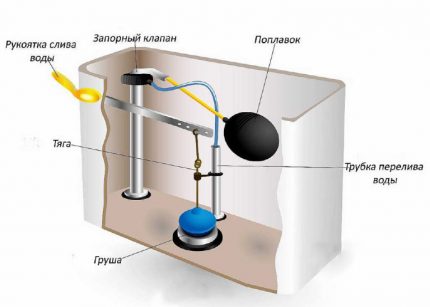
Outwardly, it is a faience (porcelain, plastic) tank, top-closed with a lid with a hole for the control lever, which is increasingly replaced by a button (single or double).In addition to this hole, there are two more: for the flow of water from the cold water system and for draining the liquid from the tank into the toilet bowl.
Fittings are installed inside the tank - a collapsible system of plastic, metal and rubber parts. The configuration, dimensions, material of manufacture of elements from different manufacturers are different. In addition, there is several types of mechanisms.
However, they are all united by the general principle of operation: water (through a flexible pipe connected to the HVS pipe) enters the required volume (on average 4.5-6 l) through the inlet into the tank.
Together with the water level filling the tank, the float also rises. When the liquid level reaches the desired level, the float device blocks the flow of water. This condition persists until flushing.
In the process of flushing, other elements of the system are included in the work. A button (or lever) drives the stem, to the end of which a membrane (or gasket) is attached. Drain valve opens and water rushes into the toilet.
The function of the float is obvious - adjusting the volume of water entering the tank. If the mechanism fails, water will flow continuously, and another important element of the system will save the apartment from flooding - overflow.
Types of float devices
The type of float in the tank of a compact toilet bowl depends on the design of the fittings: in the old-style devices, there are plastic balls or cylinders floating on the surface of the water, in new versions these are moving elements that slide vertically and resemble a glass.
The spherical float is also called the "rocker". Indeed, the thick ceiling on which the ball is mounted resembles a household item that has become a rarity.
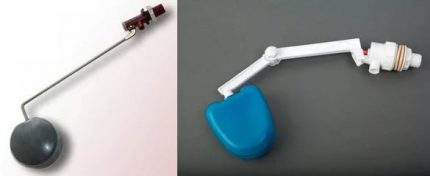
The principle of operation of the primitive, in fact, the float is quite simple: when flushed, it sinks to the bottom of the tank and opens the inlet valve by means of a rod (the same wire).
Water enters, fills the tank, and the float rises. At a certain moment, it reaches the necessary mark (adjustment of the liquid volume can be done manually) and blocks the flow of water. The inlet valve closes until flushing occurs again and the float falls to the bottom.
The modern look of the float device vaguely resembles a spherical model.This is a plastic part mounted on a vertical rod, which, like an elevator, moves up and down and is also responsible for timely blocking of the intake valve.
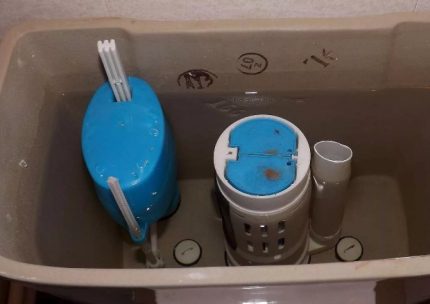
The advantage of the improved model is a more accurate adjustment of the level of water entering the tank. The rod along which the float moves is similar to a ruler with divisions, where notches are made for ease of adjustment.
Balloon floats are thought to be more noisy. In fact, the noise level does not depend on the type of float mechanism, but on the method of water supply.
With the upper side connection, it is poured from above (a flexible hose is led to the hole in the upper part), which is why noise is created. In tanks with a bottom connection, water flows quietly, and if there is noise, it is only due to malfunctioning fittings.
Brief Installation Instructions
Sometimes it is necessary to repair, replace, or simply install a new float model - separately or as part of a reinforcing block. Consider all the solutions in order. The installation of new spare parts is easiest to do, since it is not necessary to disassemble the old mechanisms, and the tank and the parts themselves are in perfect condition.
Option # 1 - installing a spherical model
We will make a reservation right away that it is necessary to mount a new device of a spherical type in the only case - if the old element is out of order. It is unlikely that the new model of the toilet is equipped with a filling / flushing system with this type of float.
A plastic ball or other shape of the part can be purchased separately, since the advantage of the outdated mechanism is that the "rocker" is easy to install or change without replacing the stock-shaped water drainage system.
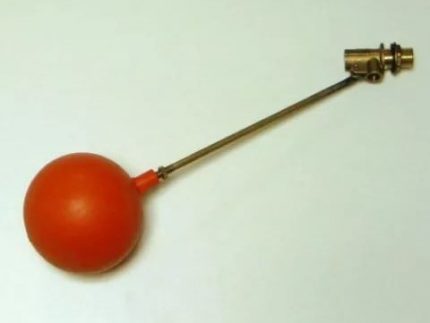
The float is usually sold with a metal holder and a filling valve. The latter is inserted into the water inlet opening (located in the upper part of the tank, on the left or on the right) and fixed, the "rocker" is placed horizontally.
Around the middle part, it is attached to the “pear” - the rod-type outlet valve. When pouring liquid into the tank, the plastic ball should lie freely on the surface of the water.
Option # 2 - installation of a glass-like view
Kits designed for containers with a lower eyeliner are usually fixed in the tank even before it is installed in its rightful place - the toilet shelf. This is necessary, since both valves - drain and inlet - are located at the bottom of the tank, and during installation, parts should be tightened and tightened on both sides.
If the tank is already installed, dealing with this will be difficult.
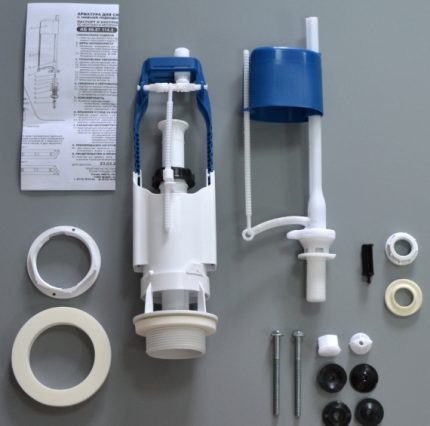
First, a more voluminous drain mechanism is installed, be sure to use the gaskets and washers that come with the kit. Align the device along the axis and tighten the nut from the outside. It is important that the o-ring fits snugly in the area of the hole.
Then, according to the same scheme, a bulk valve with a float device is fixed. It is usually allowed that the parts touch each other or the walls of the tank, but it is better to try to fix them strictly vertically.
Particular attention should be paid to sealing the junction of devices to the holes. It is necessary to use all seals, washers and gaskets that are recommended by the manufacturer and are supplied in the package, with the exception of spare parts. If difficulties arise, just look at the installation instructions.
The float device is replaced in the same way, only before installing a new one it is necessary to dismantle the old one.Will have to repair disassemble the drain tank toilet bowl.
Hand-held float adjustment
We turn to the information that often worries owners of both old models and new blocks. We will try to figure out how to independently adjust the float in the toilet to raise / lower the water level in the tank.
A larger volume of water is needed if the capacity in the tank is not enough for a good flush, but the amount of water collected is reduced if they want to save.
Process adjustments different models are different. The outdated rocker arm can be adjusted in a very simple way, without even turning off the water. We remove the tank cap, find the wire-holder of the float and simply bend it.
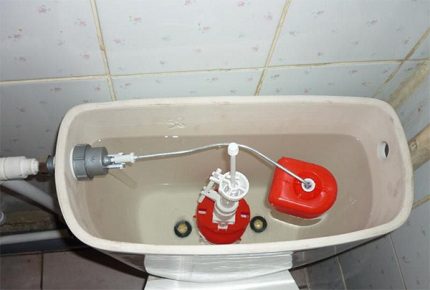
Due to the kink, the intake valve blocking device is activated earlier, therefore, the volume of water entering the reservoir also decreases.
If the float holder is assembled from two stiff metal strips connected by a bolt, the adjustment process is somewhat more complicated:
If the lever is not metal, but plastic, you cannot bend it - you will break it. Such devices are usually provided with a screw or “ratchet” to change the shape of the lever. You just need to turn the screw or move the element on the “ratchet”.
Adjusting the plastic fittings of the glass type will take a little longer. The task is to move the float on the “sliders” (plastic vertical elements that support it) up or down, depending on the planned increase / decrease in flush volume.
Very often, one of the “sliders” (or both) is equipped with a scale by which you can determine the exact height of the water level. Manufacturers in the instructions print correspondence tables, according to which you can see how high the water level will be when choosing one or another division on the scale.
To simplify the adjustment procedure, some manufacturers equip the design with a special screw. How to use it, consider using the photo gallery.
In the same way, if necessary, you can increase the amount of water entering the tank. As you can see, the procedure is very easy and does not require special knowledge.
Valve repair
Troubles usually happen unexpectedly when it is not possible to call a specialist or seek help from more knowledgeable people, so you should always be prepared for independent actions.
Breakage of the float mechanism may Destroy the work of the drain tank, and rinsing each time with water from buckets is an uninteresting occupation. We will figure out how to quickly change or repair the float in the toilet, if it has become unusable.
Plastic ball leakage
When the old float is worn, a crack may occur, which will eventually turn into a hole. Liquid will start to flow through the hole into the plastic ball and it will no longer be able to float and block the inlet valve. There is a problem - constant flow water in the toilet. Water losses very quickly turn into financial costs.
Find out how to avoid this:
- turn off the water;
- remove the float;
- wipe it dry;
- we cover the crack with waterproof sealant;
- dried;
- fix the float in the tank;
- We verify his work.
It does not make sense to repair a float with a large hole or completely leaky plastic, in this case we rush to the store and purchase a new part for replacement.
If the float valve is filled with water due to a broken membrane or crack in the valve, this sealing device must be changed:
Warp float design
Due to the wear of rubber (silicone) seals or due to poor water quality, a bucket-type float device may skew.
The plastic float “sticks” with every drain of water, does it even stop moving up and down relative to the guiding “sliders”. Depending on its position, either the flow of water into the tank stops, or, conversely, it constantly pouringflowing straight into the sewer.
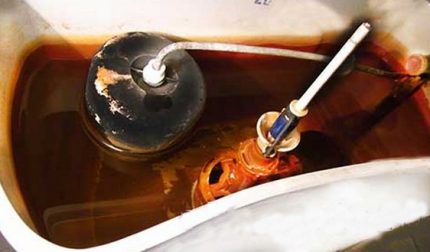
First, try to clean the mechanism without disassembling the entire structure. Perhaps the movement of the float slows down the debris that has fallen into the water. If this does not help, you will have to shut off the water, dismantle the tank, and then the float unit. Do not touch the drain device.
Next, we carry out the diagnostics and proceed according to the results: we correct the position of the float and install it in place or completely change the unit responsible for the water inlet.
Most often, breakdowns associated with a change in the position of the structure are corrected quickly, while worn-out appliances should not be repaired, but replaced with new ones.
Conclusions and useful video on the topic
A few useful tips will help you quickly deal with the replacement, installation or adjustment of a new float.
Briefly about the arrangement of the toilet bowl and the drain tank:
Mounting fittings:
Water level adjustment:
The float mechanism is not so complex a device that when it is replaced, adjusted or installed, it is time to invite a specialist. The simplest procedures can be performed independently, using simple instructions.
To repair and replace the float as little as possible, you need to monitor the quality of the water - for example, install filters.
Is there anything to supplement or have questions about the device and repair of the float mechanism? Please leave comments on the publication. The contact form is located in the lower block.

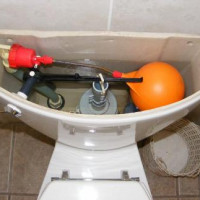 Flush mechanism for the toilet: device, principle of operation, an overview of various designs
Flush mechanism for the toilet: device, principle of operation, an overview of various designs 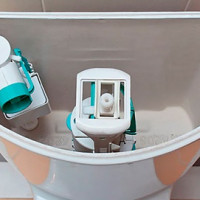 Setting up the toilet fittings: how to properly adjust the spillway
Setting up the toilet fittings: how to properly adjust the spillway  Fittings for the toilet flush tank: how the spillway device works and works
Fittings for the toilet flush tank: how the spillway device works and works 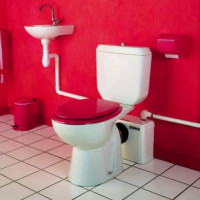 Toilet chopper pump: device, principle of operation and installation rules
Toilet chopper pump: device, principle of operation and installation rules 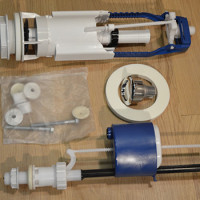 Valve for toilet: types of valves and features of their installation
Valve for toilet: types of valves and features of their installation 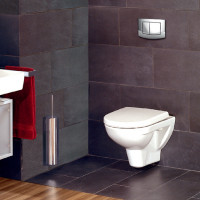 Repair of the installation for the toilet: possible malfunctions and methods for their elimination
Repair of the installation for the toilet: possible malfunctions and methods for their elimination  How much does it cost to connect gas to a private house: the price of organizing gas supply
How much does it cost to connect gas to a private house: the price of organizing gas supply  The best washing machines with dryer: model rating and customer tips
The best washing machines with dryer: model rating and customer tips  What is the color temperature of light and the nuances of choosing the temperature of the lamps to suit your needs
What is the color temperature of light and the nuances of choosing the temperature of the lamps to suit your needs  Replacement of a geyser in an apartment: replacement paperwork + basic norms and requirements
Replacement of a geyser in an apartment: replacement paperwork + basic norms and requirements
Unfortunately, the quality of water and pipes here leaves much to be desired. Yes, and the shutoff valve is not always able to hold the water collected in the tank, it often starts to let through. It is important to adjust the position of the valve relative to the drain cup so that excess water goes into the toilet, and not through the technological hole in the tank. And then such an oversight is fraught with flooding of neighbors from below and costly repairs.
There are so many drain valves on the market that one listing will take a couple of pages. Typically, the instructions are attached to the fittings, if the product is not completely left, where everything is described in sufficient detail. In case it is difficult for you, call the plumbing. The new fittings work very well, and then our water will ruin any. The drain cup is always below the process holes.
Dear users, please tell me: how much can a float in a toilet bowl (old model) cost, and how much can its replacement cost (i.e. installation work)?
Today, a neighbor (a very poor pensioner) invited the plumber to repair the tank - water flows continuously. He said what needs to be changed. I took 500 rubles from her, brought the float and installed. She says she was messing around for half an hour. In short, there was no change with 500 hundred rubles? Is this a reasonable price? In general, where can I find out the tariffs for plumbing repairs in my apartment?
I think that the price of 500 rubles in this case is quite fair, at least in our city.
See - the cost of the float is about 150-200 rubles. + the work of the master himself. I understand that for a pensioner this can be a lot of money, but such are the realities of the service market. In larger cities, plumbers only charge 500 rubles for a call. and even more!
I have a glass float. After flushing, sometimes (1 time for 7-8 flushes) does not fall and water does not accumulate. What can be done?
In your case, you need to set the optimal water level at which the float will work continuously. It may also be that the regulatory mechanism is damaged, so after a certain number of flushes, the float stops working. There are two ways out: repair the mechanism or buy a new float.